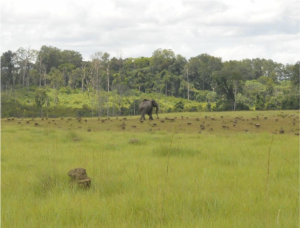 I am writing from Libreville, the capital city of Gabon. This is one of the Congo Basin forest countries where, after one month chopping trees down for my research in DRC, I am working with Proforest (an NGO based in the United Kingdom) on Environmental and Social Impact Assessments (ESIA) and High Conservation Value forests (HCV) before the conversion of 40,000 hectares into palm oil plantation by OLAM International. Since 2010, Proforest has worked with OLAM Gabon to ensure that the new plantations it is establishing in Gabon meet the rigorous environmental and social criteria of the Roundtable on Sustainable Palm Oil’s New Plantings Procedures (NPP). Proforest’s role in these assessments is to provide technical support to the local partners carrying out the regulatory ESIA, and to take the lead on the HCV reports and consultation processes which are major requirements of the NPP. Proforest’s technical support services include comprehensive independent and participatory impact assessments, including HCV assessments, which are carried out in 3 phases: Phase 1, HCV/ESIA Field Assessments; Phase 2, ESIA workshops and stakeholder HCV consultations; and Phase 3, ESIA editorial support and HCV reporting.
I am writing from Libreville, the capital city of Gabon. This is one of the Congo Basin forest countries where, after one month chopping trees down for my research in DRC, I am working with Proforest (an NGO based in the United Kingdom) on Environmental and Social Impact Assessments (ESIA) and High Conservation Value forests (HCV) before the conversion of 40,000 hectares into palm oil plantation by OLAM International. Since 2010, Proforest has worked with OLAM Gabon to ensure that the new plantations it is establishing in Gabon meet the rigorous environmental and social criteria of the Roundtable on Sustainable Palm Oil’s New Plantings Procedures (NPP). Proforest’s role in these assessments is to provide technical support to the local partners carrying out the regulatory ESIA, and to take the lead on the HCV reports and consultation processes which are major requirements of the NPP. Proforest’s technical support services include comprehensive independent and participatory impact assessments, including HCV assessments, which are carried out in 3 phases: Phase 1, HCV/ESIA Field Assessments; Phase 2, ESIA workshops and stakeholder HCV consultations; and Phase 3, ESIA editorial support and HCV reporting.
The scope of my services is directly related to an HCV assessment underway for OLAM Palm Gabon and includes the following:
- Participation in field work, primarily with flora and fauna teams, but also including participation in other field team data collection (such as hydrology and soil) to ensure quality control
- Participation in the analysis of forest inventory data and other data as relevant
- Preparing ESIA workshops and stakeholder HCV consultations
My responsibilities involve data collection in the field with Gabonese experts and colleagues working with Proforest on HCV assessments and stakeholder consultations. We started our mission with a meeting in Libreville before heading to the field. Switching from the VIP hotel to the tents in the jungle is an amazing experience. But what kind of jungle is this? Together with my colleagues we discovered a spectacular mosaic of forest-savannahs with plenty of elephants, buffalos and panthers across our transects. A high diversity of wildlife species and lovely wildlife habitats, including savannahs, periodically flooding forests, and forest dominated by okume trees. Of course, this is not my first time seeing an elephant in the forest, but believe me in this part of the world it is pretty scary!
After many conversations with local communities living in this part of the world, I was impressed by the way people think about natural resources. The most important points that raised some questions in my mind while interacting with people and stakeholders are as follows:
- Human and wildlife conflicts due to ravaging of crops: people set up scarecrows, but they think the best way to protect their crops is shooting and eating the wildlife;
- Conservation ideas in developing countries: conservation projects involve protecting animals but don’t take into account the socio-economic aspects of wildlife;
- Alternatives for human livelihoods and development in Africa;
- Deforestation and conversion of forests to plantations as an alternative to creating jobs for local communities.
One of my technicians told me he would never forgive somebody who tells him to stop hunting and eating bush-meat. When I asked him why, he said: “It’s tasty and helps feed my family [cultural reasons and a source of protein], I make money because people need them [a source of income] and they ravage our crops [an example of human-wildlife conflict].” Although people in this area welcome the development of palm oil plantations because they will get jobs, they still need this forest for agriculture, hunting and non-timber forest products. What sustainable management models do we need to preserve biodiversity and strengthen social benefits and economic needs? This technician kept his gun during our five-day camping in the middle of the forest!
I believe that promoting environmentally appropriate, socially beneficial, and economically viable management of the world’s forests will help maintain or improve the management of biodiversity and HCVs within forests and concessions.
Sustainable management models must inspire a living planet where people and nature coexist in harmony, biodiversity is maintained, and human livelihood is enhanced. This is the reason why I strive to put my energy towards identifying high conservation value forests to influence sustainable management decisions.